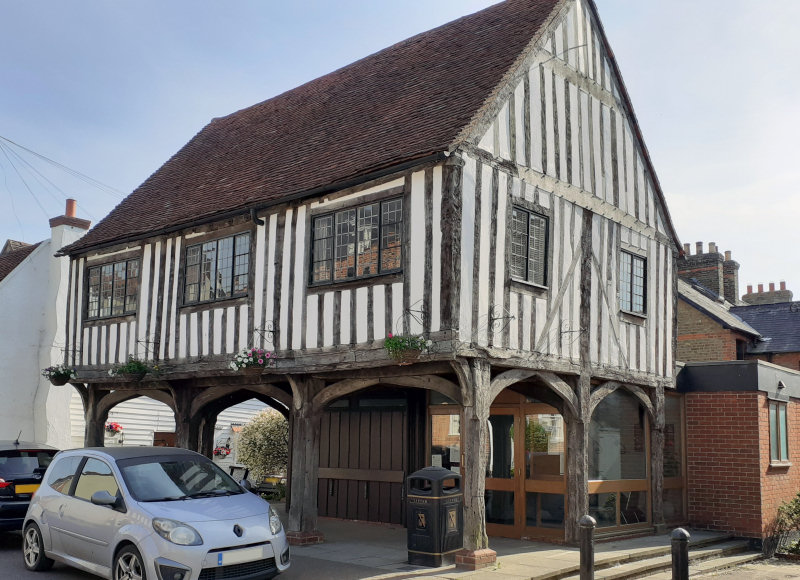The Horndon Woolmarket
Built in the early 16th century, little is known about the early history of Horndon's Woolmarket apart from the fact that it belonged to the manor of Arden Hall. A manor was an area of land owned by the crown but granted to noblemen by the king in return for the providing of services such as men, horses and weaponry, if and when needed.
The Horndon estates were inherited by Sir John Shaa from his cousin Hugh Shaa in 1491. 10 years later, Sir John Shaa was Mayor of London, and in this role he officially greeted Catherine of Aragon when she arrived from Spain.
It is not certain, but it seems probable that John Shaa established the idea of having a Wool Market House in Horndon. He held the manor of Arden Hall and was licensed to trade in wool and woollen cloth. He died in 1503, however, and was succeeded by his son Edmund, whom – it is assumed – lived to see the Woolmarket built and to witness it in operation.
Photo below: Horndon Woolmarket (credit: Michelle Savage).

Despite the importance of the wool trade, the Woolmarket was probably used for a variety of other activities, including the manorial court. This was a method of settling disputes over property, trespassing, inheritance and various other matters.
Records show that these courts were held at Arden Hall until a sudden move to 'Horndon Market' in 1525. This suggests that there was then a suitable venue available at the Manor of Horndon Market and most of the subsequent courts took place there.
By the end of the 16th century, the Essex wool trade was in decline. Written records reveal that the wool market in Horndon was no longer operating in 1594, but the building itself continued to be used for trading in other everyday items and for the manorial courts.
In 1685, the court rolls end and the Woolmarket's function changed from this point onwards. It was no longer a place of business and instead benefited Horndon's poor through a charity set up by John Poley, a descendant of Edmund Shaa's daughter Alice. Poley's Charity is noted in the Commissioner of Charities report, 1819 to 1837, which says the Market House was divided into 3 separate dwellings 'for the sole use and benefit of three poor inhabitants of the said parish of Horndon...'
In 1908, the Woolmarket was scheduled for preservation but continued to operate as a charity, providing accommodation for the poor. A wide selection of community activities took place there, ranging from a Sunday school to meetings of the Rural District Council and an election committee. During the Second World War it became an air raid precautions (ARP) first aid post.
By the 1960s, the upkeep and repair of the building was becoming a serious problem – so much so that the last two remaining families in residence there were re-housed and the Woolmarket was boarded up. A plan was developed to restore the building in its original style as thoroughly as possible but also to add facilities that would enable it to become an arts and social centre. In 1969, Thurrock Urban District Council agreed to the project and awarded a grant of £10,000.
A group of men, each with highly specialised skills in the restoration of buildings, was employed to carry out the work. During the course of the restoration, Randal Bingley of Thurrock Local History Museum carried out an emergency excavation, looking at 3 separate areas of ground. In a short period of time, numerous artefacts were discovered, including 2 medieval pins, a token, a medieval pot, bones and part of a jug dating from around 1830.
The team of craftsmen experienced many difficulties during the repair of the Woolmarket due to several centuries of general deterioration. These were eventually overcome through time and patience. The finished building was, in fact, given an award by the Southend section of the Royal Institute of British Architects.
The fully restored Woolmarket was officially opened on Saturday 13 June 1970. Its focal point was the open arcade, which acted as a gathering place for the village. It also had 3 meeting rooms and a small kitchen.
During the period following its opening, the building was open for coffee every morning and was also the venue for many evening events and activities. Coffee is no longer served, but the Woolmarket continues to act as a cultural centre for Horndon, with a busy schedule of cultural and community events.
To find out more about the village, go to our Horndon parish page.
References
Sources for this article were:
- Austin, D. and Austin, H., The Woolmarket, Horndon on the Hill. Panorama 16 p6-16. Thurrock Local History Society (1973)
